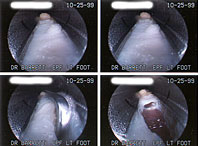|
Return to Articles Main Page
Heel pain caused by inflammation of the ligament at the bottom of the foot (plantar fascitis) is often described as a "stone bruise" by the patient. Pain is usually worse in the morning, especially with the first several steps, or after periods of rest when first standing. As the pain worsens, the heel can hurt even while not weight-bearing.
|
What causes it?
Heel pain may be caused by many different factors ranging from something simple like abnormal mechanics to complex metabolic diseases such as Reiter’s syndrome. Most heel pain is related to the plantar fascia, a wide ligament beginning behind the toes and extending the length of the foot and partially attaching into the heel bone. Many times the patient is mistakenly diagnosed, or has additional masked pathology such as a nerve entrapment. Heel pain is believed to affect more than 2 million Americans each year, and accounts for more visits to a doctor than any other foot condition.
How is it diagnosed?
In order to assure a correct diagnosis of what is actually causing heel pain syndrome, it is necessary to implement several diagnostic modalities in order to make an accurate diagnosis, and assure the best treatment outcome for the patient. These studies will almost always include x-rays. Additional studies that may be ordered could include diagnostic musculoskeletal ultrasound, Neurosensory Testing and MRI. With the ability to accurately stage and grade the degree of plantar fasciitis, a customized treatment protocol will be selected for each individual patient. This type of diagnostic work-up and assessment has been pioneered by Dr. Barrett, and is not widely available at this time. By knowing the actual degree of degeneration in the tissue of the plantar fascia, a better and faster treatment regimen can be instituted. Most cases of plantar fasciitis can be treated successfully with non-surgical intervention. |

 |
If all conservative, non-surgical treatments have failed, then surgery may be indicated. The EPF technique is a minimally invasive, endoscopic technique, which releases a portion of the tight plantar fascia. Dr. Steven Barrett, a podiatrist in Arizona is the inventor of this technique. There have been more than 1 million of these procedures performed since 1990, when the technique was developed.
This new method uses an endoscope which is a small instrument that allows the surgeon to see "anatomy" inside the body-when used in joints, it is called an "arthroscope". By using a very small incision, less than ½ inch, the procedure releases the extreme tension on the plantar fascia which is the cause of the pain in the majority of cases. All of this is viewed on the television monitor by the surgeon. The procedure itself usually takes less than 10 minutes using local anesthesia and IV sedation in an outpatient setting. A sterile dressing is worn for approximately 3 days and then the patient is usually allowed to return to regular shoe wear. Minimal loss of work is incurred.
With the older, traditional heel spur surgery, treatment requires a large surgical incision across the inner side of the heel and outpatient hospitalization. A painful recovery period of 4-6 weeks with a gradual return to soft shoes after 2-4 weeks is normal. Often, patients miss work for many weeks and are unable to bear weight on the heel during this time. It is important to note that most heel pain can be treated effectively without surgery. Treatment may include an anti-inflammatory medication, a tape strapping of the foot to take pressure off the ligament, and in-shoe supports to redirect the pressure off the spur area.
Return to Articles Main Page
Our Services | Referring Physicians | About Us | Frequently Asked Questions | Blog | Articles
Surgical Animations | Links | News & Press | Photo Gallery
Contact Us | Home | Legal Notice | Privacy Statement | Site Map
Copyright © Buffalo Medical Group P.C. / Podiatry Affiliates
Website Design, Maintenance and Hosting by Catalyst Marketing / Worry Free Websites |
